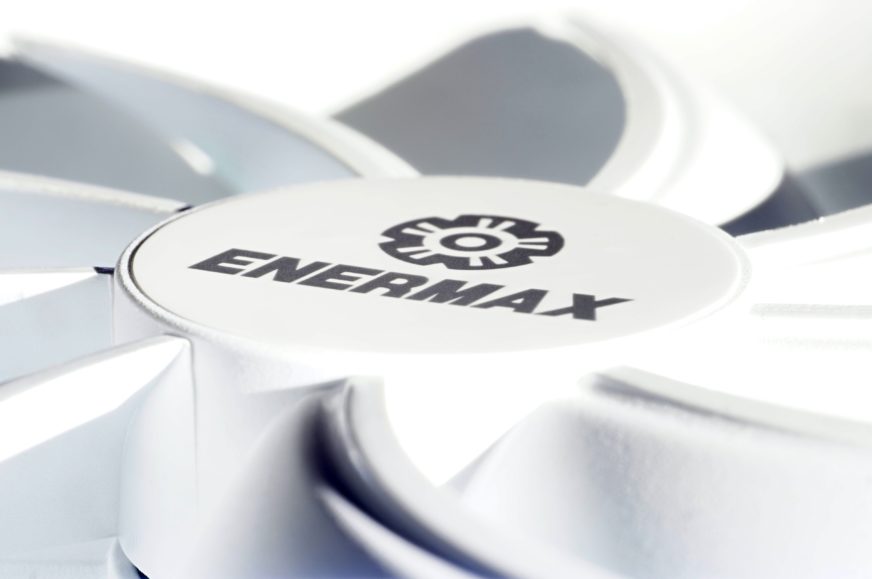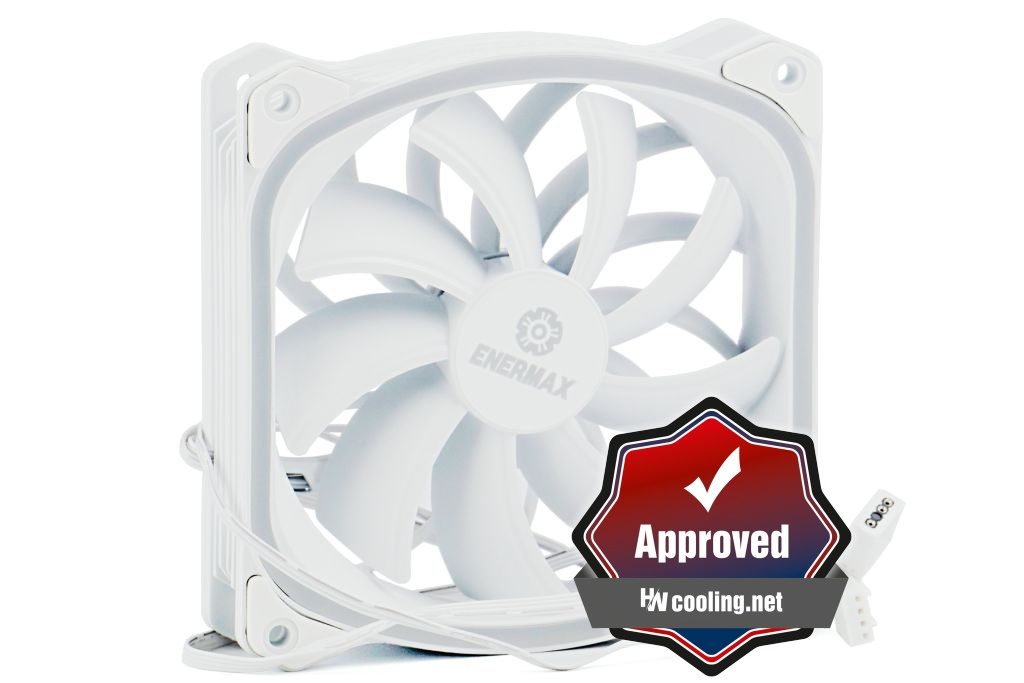Evaluation
Apart from the all-white design, which is rare in itself, this fan also stands out from the competition in other ways. Some of these need a cautionary finger raised, others deserve praise. Often for trying to differentiate themselves and even in a rather elegant, useful way. In the mix of everything about the SquA RGB fan, one can state its unique identity, for which it may win you over. But it also doesn’t have to.
Evaluation
Among the 120mm models with ARGB LED, the SquA RGB White delivers decent results. Although Enermax explicitly warned us not to expect miraculous efficiency and that the strengths should be in appearance, in most settings, in airflow through radiators, it outperforms fans such as the FD Aspect 12 RGB PWM or the Gigabyte Aorus 120 ARGB, i.e. direct competitors. Enermax SquA RGB White usually achieves higher airflow at equal noise level. On a thinner radiator (with more fin density) and even on a thicker radiator (with fewer fins per inch). The Enermax fan doesn’t fall short even on a hexagonal grille, but it should be noted here that, as with fans with geometrically similar rotor types, higher tonal peaks at 370 Hz are achieved at lower speeds.
This fan is not very suitable for plastic filters. Especially at lower speeds the effectiveness is weaker and in relation to the price it is then a rather unattractive choice for this use case. On the other hand, there is full support with nylon filters, that is, even with unreinforced designs with a looser mesh. It can’t be argued that here those results are mind-blowing, but the SquA RGB White is trailing fairly closely even behind the Noctua NF-P12 redux-1700 PWM, which is still a decent showing.
From a cooling perspective, the SquA RGB White can be rated as an average fan, but one that comes with extra added value in other features. As one of the few fans, it allows you to connect RGB LEDs even to builds that don’t have specific equipment for it (3-pin connector on the motherboard and external remote). This comes at the cost of many compromises in the form of fixed setting and high-frequency whistling, albeit faint. But if you own an older build and would like to, say, visually upgrade it, you won’t find many more suitable alternatives than the SquA RGB fans.
Enermax also strives for superior compatibility by supplying several adapters (including one with a VDG connector for Gigabyte motherboards). This, too, is important to consider before noting that the price-to-airflow ratio of the Enermax fan is only below average. The energy efficiency (airflow per unit of power draw) is also below average, but the vibration is also below average (and that’s good, even very good this time). These can be described as truly negligible. Given the lower build detail quality the vibrations are perhaps surprisingly low, from 1200 rpm downwards, they are below the resolution range of the sensitive measuring mechanism we use to analyse them.
The luminosity of the LED is quite high considering the type of lighting used (light guide around the bezel), significantly higher than, for example, the BeQuiet! Light Wings fan. So the lighting can be very bright, but it can also be greatly dimmed if necessary. The efficiency of ARGB LEDs is also higher than that of BeQuiet! fans (higher luminosity per watt is achieved). So Enermax knows how to elegantly reflect light outwards. And it’s not even at the price of something shining through. On the contrary, the light diffusion is nicely even. If something shines through somewhere, it is only through the poor jointing of some parts.
The SquA RGB White can be described primarily as a flashy fan with above-standard compatibility. However, Enermax does not put all its eggs in one basket. In addition, there is also competitive effectiveness when it comes to cooling properties. So apart from that worse first impression with hickups in the manufacturing details…
English translation and edit by Jozef Dudáš
| Enermax SquA RGB White |
| + Suitable for every use case |
| + Decent price/cooling performance ratio for a lighted fan |
| + Cooling efficiency (airflow/pressure per unit of noise) at a high level |
| + Wide speed range |
| + Virtually noiseless operation of bearings and motor |
| + Extra-low, negligible vibration |
| + Original ARGB LED lighting |
| + Superior compatibility... |
| + ... whether it's the extra adapters included in the package or the RGB LEDs which also work via 4-pin PWM |
| - Does not support passive mode, does not "turn off" at low PWM intensity |
| - Some mismatch with a hexagonal grille, may amplify the 370 Hz frequency more significantly |
| - Weaker build quality |
| Approximate retail price: 20 EUR |
- Contents
- Detaily Enermax SquA RGB White
- Overview of manufacturer specifications
- Basis of the methodology, the wind tunnel
- Mounting and vibration measurement
- Initial warm-up and speed recording
- Base 6 equal noise levels…
- ... and sound color (frequency characteristic)
- Static pressure measurement…
- … and airflow
- Everything changes with obstacles
- How we measure power draw and motor power
- Measuring the intensity (and power draw) of lighting
- Results: Speed
- Results: Airlow w/o obstacles
- Results: Airflow through a nylon filter
- Results: Airflow through a plastic filter
- Results: Airflow through a hexagonal grille
- Results: Airflow through a thinner radiator
- Results: Airflow through a thicker radiator
- Results: Static pressure w/o obstacles
- Results: Static pressure through a nylon filter
- Results: Static pressure through a plastic filter
- Results: Static pressure through a hexagonal grille
- Results: Static pressure through a thinner radiator
- Results: Static pressure through a thicker radiator
- Results: Static pressure, efficiency by orientation
- Reality vs. specifications
- Results: Frequency response of sound w/o obstacles
- Results: Frequency response of sound with a dust filter
- Results: Frequency response of sound with a hexagonal grille
- Results: Frequency response of sound with a radiator
- Results: Vibration, in total (3D vector length)
- Results: Vibration, X-axis
- Results: Vibration, Y-axis
- Results: Vibration, Z-axis
- Results: Power draw (and motor power)
- Results: Cooling performance per watt, airflow
- Results: Cooling performance per watt, static pressure
- Airflow per euro
- Static pressure per euro
- Results: Lighting – LED luminance and power draw
- Results: LED to motor power draw ratio
- Evaluation









